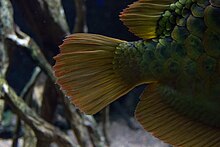Asian fork beard
| Asian fork beard | ||||||||||||
|---|---|---|---|---|---|---|---|---|---|---|---|---|

Asiatic fork beard ( Scleropages formosus ) |
||||||||||||
| Systematics | ||||||||||||
|
||||||||||||
| Scientific name | ||||||||||||
| Scleropages formosus | ||||||||||||
| ( Schlegel & Müller , 1844) |
The Asiatic forked beard ( Scleropages formosus ), also known as the Asiatic Bone Tenderizer or Asiatic Arowana , is a predatory fish from the family of the Bone Tongues (Osteoglossidae).
description
The Asian fork beard can be up to 90 cm long, but in most cases it remains significantly smaller (max. 60 cm). He has an elongated and slender, laterally flattened body. The body height is about a quarter of the standard length . The head is long and slender. The mouth is slanted, the maxillary long and reaches far behind the rear edge of the eye. There are two short, thick barbels at the tip of the lower jaw . The pectoral fins are long (about a third of the standard length) and reach the base of the pelvic fins, which are only half as long as the pectoral fins. The anal fin is short (less than 28% of the standard length). The dorsal fin is short and reaches half to 3/4 of the anal fin length.
The Asian fork beard has a dark olive-green back and silvery or green-gold body sides. The scales are big. There are dark green or dark blue spots on the scales along the sideline . This can be mood dependent. The ventral side is whitish or silvery. The fin membranes are greenish, in the population from Sumatra bluish-purple.
- Fin formula : dorsal 17–19, anal 24–27, pectoral 7, ventral 5.
- Dandruff formula SL 21–26.

distribution
The Asian forked beard occurs in southern Thailand , Cambodia , southern Vietnam , the Malay Peninsula and most of the river systems of Sumatra and Borneo .
Systematics
Various color morphs were known of the Asian fork beard, three of which were described as separate species in 2003 after the analysis and comparison of mitochondrial DNA and morphological external differences , the golden arowana ( Scleropages aureus ) from Sumatra, as well as the red arowana ( Scleropages legendrei ) and the silver Arowana ( Scleropages macrocephalus ) from Kalimantan . In Scleropages formosus , only the green colored morph and a bluish bony bones population from the Malay Peninsula remain, which could not be investigated because no type specimen was available. The silver arowana is the sister species of the Asian forked beard, the other two species form the sister group of the silver arowana and the Asian forked beard.
Way of life
The Asian fork beard lives on the banks of fast or slow flowing rivers. The pH value described as favorable for reproduction lies in the range 7.6–7.8. It feeds on fish, frogs and large insects, which it hunts on the surface of the water.
Reproduction
Scleropages formosus reaches sexual maturity at three to four years of age. At this point it is 45–60 cm long. The spawning season extends over the months of July to December in its traditional areas of distribution . The eggs are laid one to two weeks after mating . A mature ovary 1.9 cm in diameter houses 20–30 eggs, so that a female can lay between 10 and 60 eggs that are a good 10 mm in diameter. The male ingests the fertilized eggs with his mouth (parental mouthbrooders ). The hatching fry are 6–7 cm long. They stay in the male's mouth until their yolk sac is completely used up.
Relationship with people
In Asia, the fork beard has long been considered a family fish and good luck charm. Similar to the Koi , it is also viewed as a symbol of luck and prosperity in Feng Shui . Its status is considered critically endangered , as it has become rarer in its entire area of distribution. Reasons for this decrease can be found in human activities, among other things. Natural habitats where this fish lives are being degraded. Swamps are often turned into agricultural land and forested habitats are converted into plantations or destroyed by forest fires. Furthermore, these fish have been kept in aquariums since the 1970s, but some nations restrict or prohibit the possession of this species. Despite registered breeders, there was illegal trade. Today the market is regulated, but not optimal and therefore natural specimens are still exploited by traders today. The fish are protected by the Washington Convention and the EU Species Protection Ordinance.
literature
- Günther Sterba : The world's freshwater fish. 2nd Edition. Urania, Leipzig / Jena / Berlin 1990, ISBN 3-332-00109-4 .
- Martien JP van Oijen & Sancia ET van der Meij: The types of Osteoglossum formosum Müller & Schlegel, 1840 (Teleostei, Osteoglossidae). Zootaxa 3722 (3): 361–371 (October 23, 2013), doi: 10.11646 / zootaxa.3722.3.5 , PDF .
- Laurent Pouyaud, Sudarto, Guy Teugels: The Different Color Varieties of the Asian Arowana Scleropages formosus (Osteoglossidae) are distinct species: Morphologic and genetic evidences. In: Cybium , 27, No. 4, December 2003, pp. 287-305.
- Ronny Wartenberg: Arowana . Degen Mediahouse, 2013, ISBN 978-3-942 596-07-7 .
Individual evidence
- ↑ Mohamad Zaini Suleiman: Breeding technique of Malaysian golden arowana, Scleropages formosus in concrete tanks. In: Aquaculture Asia , 8, No. 3, 2003, pp. 5-6.
- ↑ DBC Scott, JD Fuller: The reproductive biology of Scleropages formosus (Müller & Schlegel) (Osteoglossomorpha, Osteoglossidae) in Malaya, and the morphology of its pituitary gland. In: Journal of Fish Biology , 8, No. 1, 1976, pp. 45-53, doi : 10.1111 / j.1095-8649.1976.tb03906.x .
- ↑ Scleropages formosus in the IUCN 2017-3 Red List of Threatened Species . Posted by: Kottelat, M., 2011-02-20.
Web links
- Asian fork beard on Fishbase.org (English)
- Scleropages formosus in the endangered Red List species the IUCN 2007 Posted by: M. Kottelat, 1996. Accessed on 09/03/2008.
